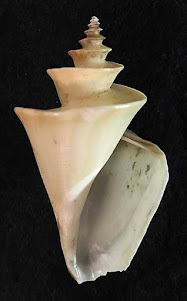This post concerns three examples of seashells thought to have been extremely rare, hence they were very expensive to buy. Eventually, divers and collectors discovered their habitats and found numerous specimens, hence they were no longer rare nor very expensive to buy. The three examples illustrated and discussed here are Epitonium scalare (Linnaeus, 1758), Thatcheria mirabilis Angas, 1877, and Conus gloriamarus Perry, 1810.
Epitonium scalare (Linnaeus, 1758)
Common name: “Precious wentletrap.” This name is derived from the Middle Dutch word “wendeltrappe,” used to describe a winding spiral staircase. It is not easy to see in most available photographs, but the whorls in fact do not touch. They are held in placed by the pronounced flaring ribs (costellae), which do touch (see image below).
Family: Epitoniidae
Distribution: Locally common in Japan and southwest Pacific (including eastern Australia), and East Asia.
Habitat: Subtidal to 29 m deep. They feed primarily on sea anemones.
The Background Story: These shells were once considered to be so rare that crooks made and sold fake ones out of rice flour. Now these fake replicas are priceless, and the real E. scalare shells are only moderately expensive.
Three views: Front, back, and right side of E. scalare, height 4 cm, width 2.1 cm.
The next view (below) of the same specimen is an oblique showing rib supports for the “spiral staircase.” This back-lit view of a tilted specimen shows open space (indicated by the green-background color “peaking through” between the whorls when viewed at just the precise angle.
Thatcheria mirabilis Angas, 1877
Common name: “Japanese wonder shell”
Family: Raphitomidae.
Distribution: Endemic to Japan and Taiwan (plus, it might occur in the Philippines).
Habitat: Muddy sand bottom, between about 400 and 500 feet deep.
The Background Story: Rarely found until the 1950’s, when more specimens were found. The shell of this gastropod has been mentioned as one of the most beautiful seashells and probably the most distinctive-shaped gastropod on Earth. This is because of this species has extremely keeled whorls .
Abstract computerized images, made via mathematical equations, can look nearly identical to actual T. mirabilis specimens (Fowler et al., 1992). Shells are three-dimensional spirals. Those that spiral down an axis will look different than those that spiral around a central point. The formula for the logarithmic spiral (curve) of shells was discovered 385 years ago by René Descartes, a philosopher and mathematican. The principle is that as a shell grows, its curve never changes. It just expands in size. The mathematical-produced images are not always perfectly exact, but they are very close to what is seen in real shells (e.g., cone shells, olive shells, etc.).
Two views: Thatcheria mirabilis front and back views, height 7 cm, width 3.5 cm.
Reference:
Fowler, D. 1992 (May issue). Shell game, creating shells out of nothing but mathematical equations, a computer scientist holds a mirror up to Nature. Discover Magazine, pp. 38–42.
Conus gloriamaris Chemitz, 1777
Common name: “Glory-of-the sea cone”
Family: Conidae
Distribution: West Pacific, especially near the Philippines.
Habitat: Sandy seafloor. Cones inject and paralyze their prey (mainly worms and small fish) with toxic darts. Some species of cones have toxins that can be fatal to humans. Please see my April 22, 2019 blog post on “Cone Shells: Past and Present,” for more information.
The Background Story: Initially, specimens were very rare, and each shell of this species sold for several thousand dollars. It is the only shell known to have been stolen from a major museum. In 1969, divers discovered the gastropod’s habitat. Since then, hundreds of specimens have been found, thereby greatly reducing its presumed rarity and, of course, its value.
Two views: Conus gloriamaris, front and back, height 8.8 cm, width 3 cm.








No comments:
Post a Comment